PY 131 Chapter 24: Magnetism
Lodestones
Several ancient cultures discovered the unusual properties of particular stones called lodestones. They found:
lodestones are attracted to pieces of iron.
a lodestone needle that is free to rotate aligns itself in a north-south direction.
Lodestones are made from the mineral magnetite but few pieces of magnetite are lodestones.
It is not known how lodestone is made in nature, it may be via lightning strikes.
Later it was found that pieces of iron could behave like lodestones if they were annealed.
Annealing is a heat treatment process for materials that them easier to work with.
The Latin word for lodestone is magnetum and nowadays we call objects which behave like lodestones, magnets.
Magnetic Poles
Every magnet has two poles which are called north and south.
the names come from magnetic compasses: the north magnetic pole of a compass needle points north, a south magnetic pole points south.
the ‘northness’ or ‘southness’ of a pole is called the magnetic polarity.
The technical name for magnet which has one north pole and one south pole is a magnetic dipole.
More complicated arrangements of poles are possible but there always has to be at least one pole of each type.
‘bar’ and ‘horseshoe’ refers to the shape of the magnet, both are magnetic dipoles.
It is not possible to make a magnet which only has one pole.
Magnetic Fields
Like charges, magnets create a field around themselves. The field can be observed using iron filings.
While it looks like magnetic fields begin and end on the magnetic poles, this is not correct
A microscopic examination of a magnet reveals that it is built from magnetic domains each itself a magnet with a field.
The arrows indicate the direction of the north magnetic pole of each domain.
In a piece of unmagnetized iron the magnetic domains are equally likely to point in any direction.
In a piece of magnetized iron, i.e. a magnet, the magnetic domains tend to point in a preferred direction.

Like electric fields, magnetic fields are vectors – they have a direction.
Unlike electric field lines, magnetic field lines form loops i.e. they do not start and end.
there are magnetic field lines in the magnet itself – the magnetic domains - which aren’t revealed in the iron filings pictures.
By convention, the magnetic field lines point in the direction of north magnetic pole of a test magnet which is free to rotate would point.
The SI unit of magnetic field strength is the tesla, symbol T.
Magnetic fields can also be created by electric currents.
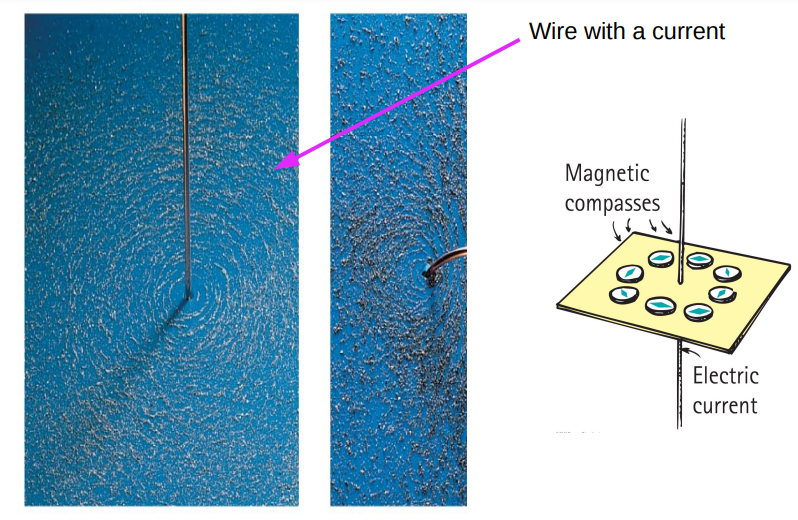
The magnetic field around a long straight wire is in the form of concentric cylinders. The field around a loop is the field of a magnetic dipole. The field around lots of loops in a row – a solenoid – is similar to the field around a bar magnet.
The direction of the magentic field around the long wire is given by the right hand grip rule.

The field from a bent wire can be constructed by breaking the wire up into small straight segments, finding the field from each straight segment separately, then adding the fields together vectorially.
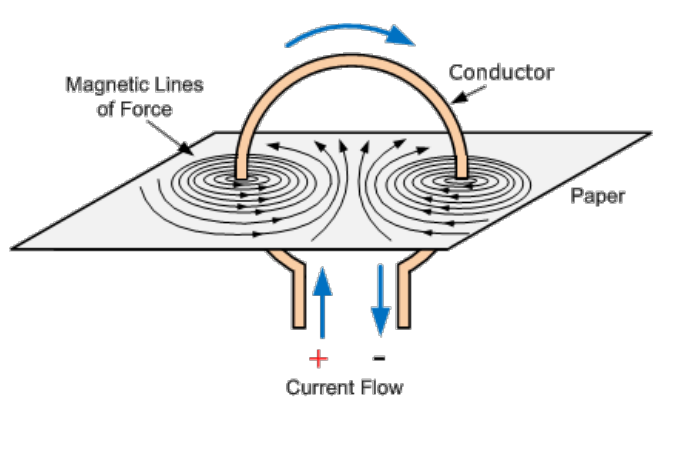
The current understanding of the origin of the magnetic fields from magnets is that they are due to electron motion.
The electrons in an atom have two kinds of angular momentum, orbital and spin, and both produce magnetic fields.

In most atoms the magnetic field from one electron is canceled by the magnetic field from another but for a few elements, such as iron, there is incomplete cancellation.
Electromagnets are the magnets made by electric currents, typically solenoids.
To increase the strength of the magnetic field created:
increase the current in the wire
increase the number of loops of wire in the solenoid
place an iron bar in the middle of the solenoid (unless you need to put something in the middle).
Electromagnets are used in MRI machines, to lift steel and iron objects (e.g. cars), and some high speed trains
The most powerful electromagnets use superconductors.
EXAMPLE 1:
Can a single isolated charge have an electric field and a magnetic field at the same time?
Yes
The charge always has an electric field. If it is moving it also has a magnetic field.
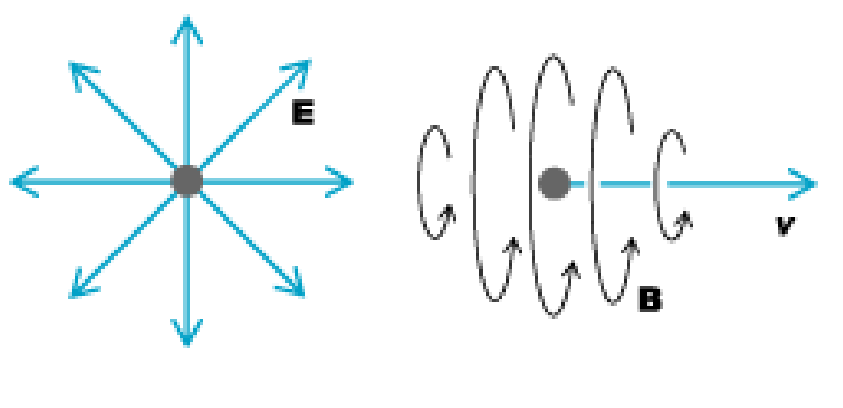
Magnetic Force
Like electric charges:
a north magnetic pole repels a north magnetic pole
a south magnetic pole repels a south magnetic pole
a north magnetic pole attracts a south magnetic pole
Also like electric charges, the force between two magnets decreases with distance but it’s not proportional to the square of the distance.
it also depends on the orientation of the magnets
Magnetic fields exert forces upon moving charges – currents.
The force is not in the direction of the current nor the direction of the magnetic field, it is perpendicular to both.
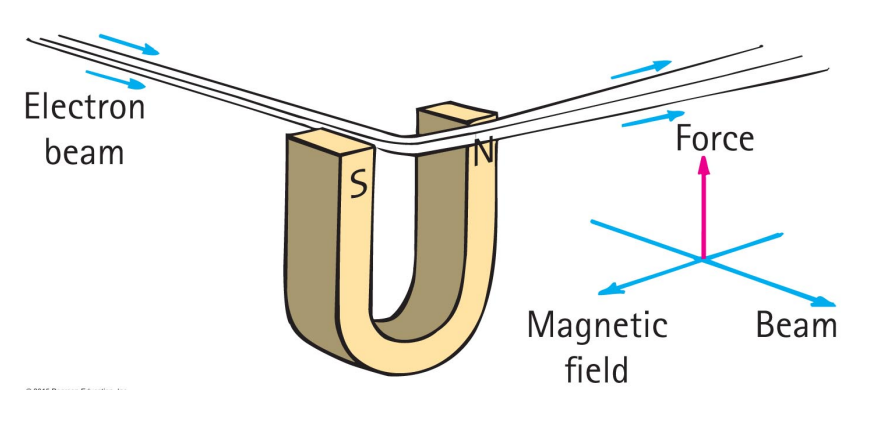
If the current is reversed then the force is reversed.
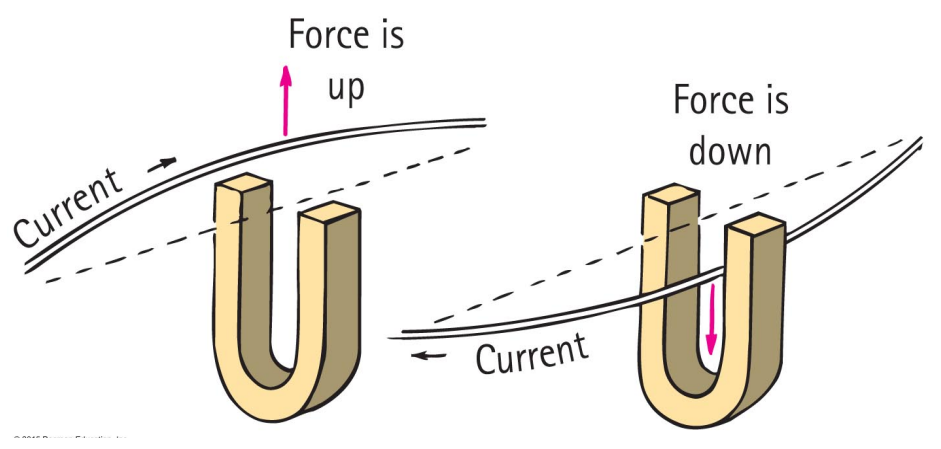
The size of the force depends upon
the larger the velocity the larger the force on the charge / current.
the larger the charge / current. the larger the force
the stronger the magnetic field the larger the force
the more the velocity / direction of current and magnetic field align, the smaller the force.
The direction of the force is given by the right-hand rule.
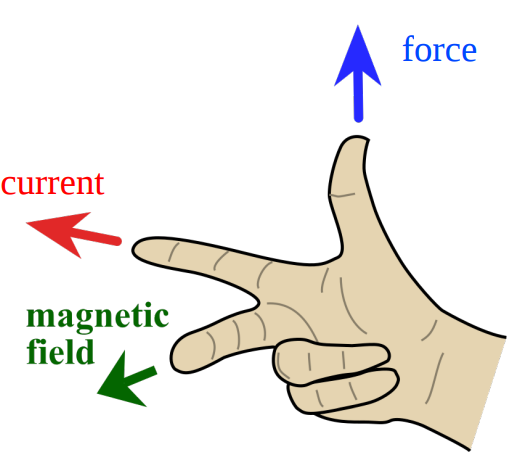
If the current and magnetic field are aligned (or anti aligned), there is no force.
EXAMPLE 1:
A magnet exerts a force on a current carrying wire. Does the wire exert a force on the magnet?
Yes.
For every force, there is an equal and opposite reaction (Newton’s 3rd Law)
The magnetic field doesn’t have to be from a magnet, it can be the magnetic field generated by another current. Consider two parallel wires carrying two currents.
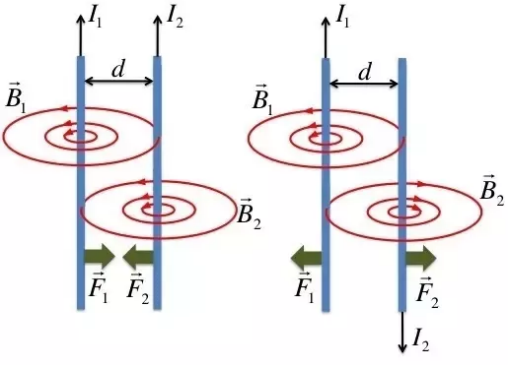
If the currents are in the same direction the wires are attracted towards each other.
If the currents are in opposite directions the wires are repelled.
The two forces are action-reaction pairs.
Electric Motors
An electric motor exploits this force from magnetic fields upon currents to generate motion (specifically rotation).
A loop of wire in which a current flows is placed in a magnetic field. The loop is mounted on a rotor which can rotate.
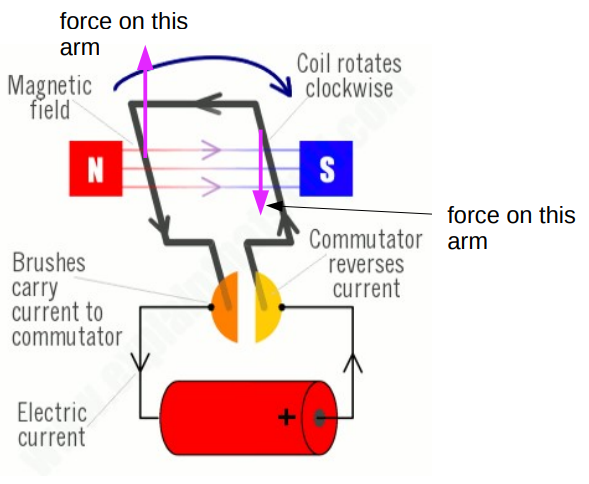
EXAMPLE 2:
The loop of wire in this motor rotates clockwise. What could you change to make it rotate counter clockwise?
Change the direction of the current: You can reverse the direction of the current flowing through the loop by either reversing the polarity of the power supply connected to the motor or by reversing the connections of the loop to the power supply.
Change the direction of the magnetic field: You can change the direction of the magnetic field in which the loop is placed by either reversing the direction of the permanent magnets in the motor or by reversing the direction of the current flowing through the field coils that produce the magnetic field.
EXAMPLE 3:
The commutator in a motor reverses the current through the loop every half rotation of the loop. Why does it need to do this?
The commutator in a motor needs to reverse the current through the loop every half rotation to maintain a continuous rotation of the motor. This ensures that the magnetic field generated by the loop interacts with the magnetic field of the permanent magnets in a way that produces a consistent torque and rotational motion.
Earth’s Magnetic Field
Earth (and several other planets plus the Sun) has a magnetic field which is similar to the field from a bar magnet.
The field is due to electric currents in the liquid core which is too hot to be permanently magnetized.
The poles of the field almost align with the geographic poles which makes the field useful for navigation.
The south pole of Earth’s magnetic field is currently located near the north geographic pole, and vice versa.
Earth’s magnetic field has reversed several times in the past and appears to be on the verge of switching again.
Earth’s magnetic field is very important for sustaining favorable conditions for life on the planet.
The field deflects high-energy particles ejected from the Sun called the solar wind.
Without the field particles in the solar wind would hit the atmosphere or even the surface of the Earth.
Some of the high energy particles are trapped in two doughnut shaped regions called the Van Allen radiation belts

Earth’s magnetic field channels some solar wind particles down to the top of the atmosphere at the magnetic poles.
When these particles strike molecules of oxygen or nitrogen the molecules emit light called fluorescence.
oxygen emits green or red light, nitrogen emits blue
The fluorescence is seen as the aurora borealis or aurora australis